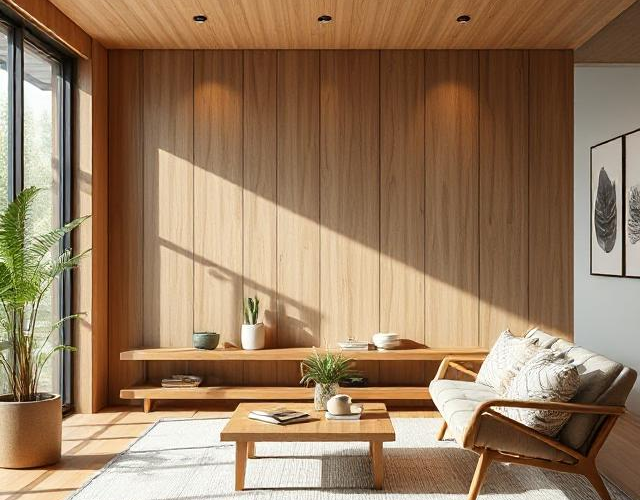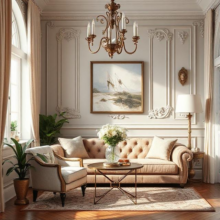The Ultimate Guide to Japandi Home Decor: A Perfect Fusion of Japanese and Scandinavian Styles

Introduction: What is Japandi Home Decor?
Japandi home decor is a design movement that seamlessly blends the elegance of Japanese minimalism with the warmth and functionality of Scandinavian aesthetics. This hybrid style has gained immense popularity in recent years, offering homeowners a perfect balance between simplicity, nature, and practicality. By combining the best elements of both cultures, Japandi creates a serene, clutter-free environment that fosters mindfulness and comfort.
In this guide, we will explore the core principles of Japandi home decor, key design elements, and practical ways to implement this style in your own home. Whether you are looking to redesign your entire space or just add subtle Japandi-inspired touches, this article will provide all the insights you need.
The Core Philosophy of Japandi Style
Japandi is more than just an aesthetic; it is a philosophy rooted in two design traditions:
- Japanese Wabi-Sabi: Emphasizes imperfection, authenticity, and the beauty of natural aging.
- Scandinavian Hygge: Focuses on warmth, coziness, and functional simplicity.
Both styles prioritize minimalism, craftsmanship, and a deep connection with nature, making Japandi a perfect fit for those who seek harmony in their living spaces.
Key Elements of Japandi Interior Design
To achieve the perfect Japandi interior, focus on the following core elements:
1. Color Palette
Japandi design leans towards neutral, earthy tones such as beige, soft grays, muted greens, and warm browns. These colors create a calming atmosphere and allow natural light to enhance the space.
2. Natural Materials
Incorporate organic materials like wood, bamboo, linen, and rattan to add warmth and texture. Opt for sustainable materials that emphasize eco-conscious living.
3. Minimalist Furniture
Japandi furniture is characterized by clean lines, simple forms, and functionality. Scandinavian-inspired pieces often feature light-colored wood, while Japanese furniture leans toward darker, richer wood tones.
4. Decluttered Spaces
A fundamental rule of Japandi decor is to remove unnecessary items and maintain an uncluttered space. Use hidden storage solutions to keep belongings organized and out of sight.
5. Handcrafted and Sustainable Elements
Handmade pottery, woven baskets, and artisanal textiles add personality and authenticity to a Japandi home. These elements reflect the value of craftsmanship and sustainability.
6. Indoor-Outdoor Connection
Large windows, sliding doors, and indoor plants help create a seamless transition between indoor and outdoor spaces. Japandi homes often incorporate bonsai trees, bamboo, and other greenery to enhance the connection with nature.
Japandi vs. Other Interior Design Styles
Japandi design shares similarities with other styles but remains distinct in its approach:
- Japandi vs. Minimalism: While both embrace simplicity, Japandi adds warmth and texture, whereas minimalism can sometimes feel stark and cold.
- Japandi vs. Scandinavian Design: Japandi has a deeper focus on tradition and craftsmanship, while Scandinavian design prioritizes coziness and functionality.
- Japandi vs. Wabi-Sabi: Wabi-Sabi celebrates imperfection and rustic aesthetics, whereas Japandi blends clean Scandinavian influences for a more refined look.
How to Incorporate Japandi in Different Spaces
Japandi principles can be applied to every room in your home. Here’s how:
Living Room
- Use a low-profile wooden sofa with neutral cushions.
- Add a mix of Japanese ceramics and Scandinavian throws for texture.
- Keep the decor minimal, emphasizing natural elements like stone or wood.
Bedroom
- Opt for a simple wooden bed frame with linen bedding.
- Use shoji-style panels or woven rattan dividers.
- Incorporate soft, warm lighting for a tranquil atmosphere.
Kitchen
- Choose wooden cabinetry with clean, streamlined hardware.
- Keep countertops free of clutter with hidden storage solutions.
- Display handcrafted ceramics or neutral-toned dinnerware.
Bathroom
- Use stone or concrete sinks for a natural look.
- Incorporate wooden shelving and bamboo accessories.
- Keep towels and essentials neatly stored in woven baskets.
Sustainability and Japandi Decor
Sustainability is a key pillar of Japandi design. Here are ways to make your home eco-friendly while maintaining Japandi aesthetics:
- Use Renewable Materials: Bamboo, reclaimed wood, and natural fibers are excellent choices.
- Invest in Quality Over Quantity: Japandi prioritizes long-lasting, durable pieces over trendy, disposable items.
- Support Local Artisans: Handcrafted furniture and decor contribute to ethical consumerism.
- Opt for Energy-Efficient Lighting: LED lighting and natural daylight reduce energy consumption.
Common Mistakes to Avoid in Japandi Interiors
To successfully achieve Japandi decor, avoid these pitfalls:
- Overloading the Space: Less is more—avoid excessive decor and furniture.
- Ignoring Contrast: Balance light and dark tones to prevent a monotonous look.
- Using Too Many Colors: Stick to a restrained, earthy palette.
- Choosing Mass-Produced Items: Prioritize handmade, high-quality pieces over mass-market decor.
Real-World Examples and Case Studies
Many designers and homeowners have successfully implemented Japandi aesthetics in real-world settings. For instance:
- Japanese-Scandinavian Apartments in Tokyo: These homes use modular furniture, neutral tones, and open layouts to enhance space efficiency.
- Minimalist Nordic-Japanese Homes in Copenhagen: Featuring handcrafted wooden elements and a seamless indoor-outdoor transition, these homes epitomize Japandi perfection.
Final Thoughts
Japandi home decor is more than just a design trend; it is a lifestyle choice that embraces simplicity, functionality, and nature. By incorporating Japandi principles, you can create a peaceful and aesthetically pleasing home that reflects balance and mindfulness.
Ready to transform your space with Japandi decor? Start by decluttering, investing in quality handcrafted pieces, and embracing a neutral color palette. For personalized design inspiration, explore Japandi-style furniture and decor collections from sustainable brands today!


